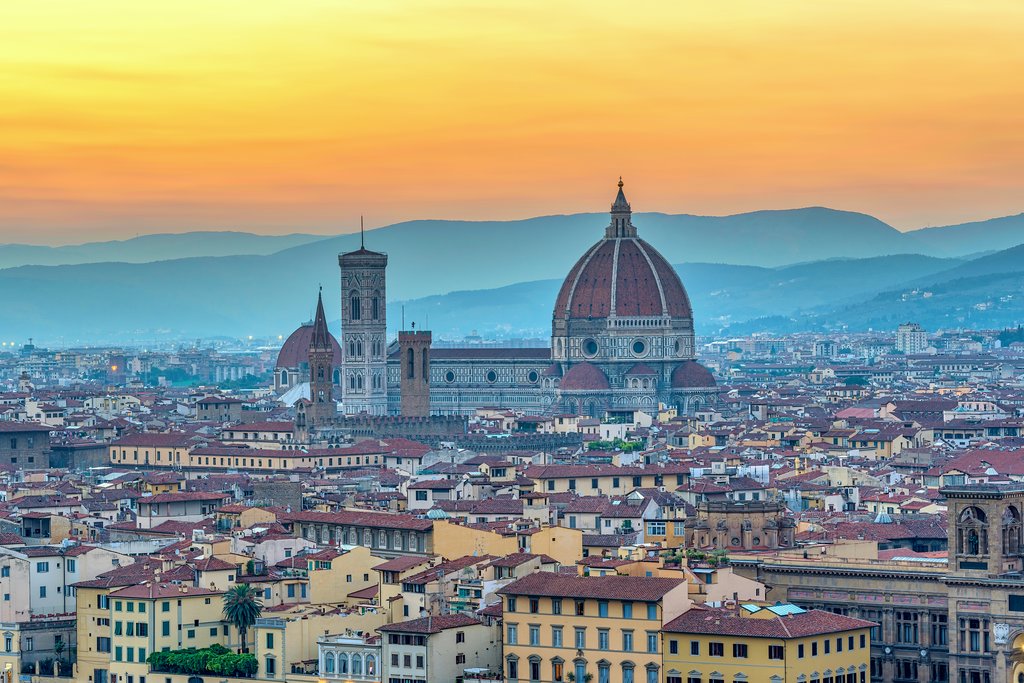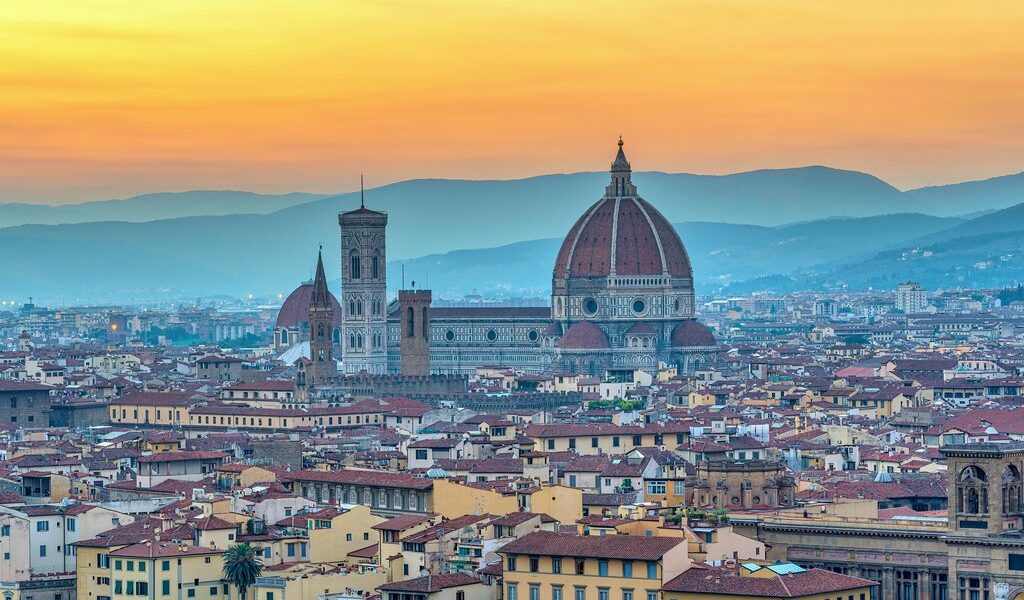
Sitting romantically astride the Arno River, topped by terracotta-tiled domes and medieval towers that lift the gaze skywards and bathed in painterly light—Florence is one of Europe’s most captivating cities. The Tuscan capital has enough Renaissance art and architecture to keep you coming back for a lifetime, but in just one day, you can get a taste of what makes the city great.
## A Comprehensive Day of Discovery: Immersing Yourself in the Splendor of Florence
Florence, a city renowned for its artistic heritage and captivating atmosphere, possesses a unique allure that unfolds with the changing light upon the Arno River, which gracefully meanders through its heart. To merely rush through this enchanting city would be to deny oneself the full experience of its beauty. Even with just a single day to dedicate to Florence, it is essential to incorporate moments of spontaneity, allowing yourself to be swept away by the city’s rhythm. Whether it’s savoring the simple pleasure of relaxing in a vibrant piazza, observing the world go by, venturing into hidden backstreets where skilled artisans perpetuate time-honored traditions passed down through generations, or indulging in a glass of exquisite Tuscan wine at a rooftop bar offering panoramic vistas of the cityscape, Florence offers countless opportunities for delightful immersion.
Embrace the slower pace and surrender to the allure of the dolce vita (the sweet life). Particularly during the summer months, when the city teems with visitors and the sun beats down relentlessly, a leisurely approach is not only preferable but almost necessary. Prepare yourself for extensive walking – the most efficient way to navigate the relatively compact center of Florence – by wearing comfortable, flat shoes. Protect yourself from the sun’s intensity with a sunhat and ample sunblock. Stay hydrated by carrying plenty of water.
To maximize your time and avoid unnecessary delays, especially during peak season, pre-booking tickets to major attractions is highly recommended. Keep in mind that many of Florence’s most renowned landmarks, such as the Uffizi Gallery and the Galleria dell’Accademia, are closed on Mondays. When visiting religious sites, remember to dress modestly out of respect for the sacred spaces. While photography is generally permitted in most locations, the use of flash is usually prohibited. Selfie sticks are also typically banned within these sites.
## 8 am: Awakening with Coffee and Renaissance Masterpieces at the Uffizi Gallery
Buongiorno! Begin your day by witnessing Florence awaken at the fountain-adorned Piazza della Signoria. Here, you can observe the city’s vibrant energy while enjoying a cappuccino and a delectable cornetto (croissant) on the terrace of the celebrated Café Rivoire. The café offers a prime view of the Palazzo Vecchio, Florence’s imposing medieval city hall, distinguished by its crenelated design. Guarding the entrance is an impressive replica of Michelangelo’s iconic “David,” a prelude to the genuine article you will encounter later in the day.
Within the Palazzo Vecchio, you can catch a glimpse of another of Michelangelo’s marble creations: the “Genius of Victory.” For a breathtaking panoramic perspective of the city, ascend the steep staircase to the Torre d’Arnolfo, commencing your Florentine experience on a literal high note. Adjacent to the Palazzo Vecchio lies the Loggia dei Lanzi, a 14th-century structure that provides shelter for the Medici lions and an array of exquisite Renaissance sculptures.
Now, direct your steps toward the Uffizi Gallery, a quintessential Florentine destination. To avoid the long queues, pre-booked tickets are highly advisable. Housed within a magnificent 16th-century palazzo, the Uffizi Gallery presents an unparalleled collection of Renaissance art. The Botticelli collection (located in rooms 10-14) stands out as a particular highlight, showcasing masterpieces such as the renowned “Nascita di Venere” (Birth of Venus).
## 11 am: Reaching New Heights at the Duomo
The Duomo, Florence’s cathedral, stands as the city’s crowning achievement and is truly unique. The magnificent red-tiled cupola and the marble-banded facade are at their most striking during the gentle morning light or as the sun sets, painting the sky with vibrant hues. Construction of the cupola began in 1296 with the intention of creating the world’s largest structure of its kind.
At the time, Florence was experiencing significant prosperity through its thriving wool and silk trade, and the city sought a cathedral that would reflect its affluence. However, it took an additional 140 years and the genius of Renaissance master Filippo Brunelleschi (originally a goldsmith and sculptor) to complete the Duomo’s cupola in 1436. Subsequently, Renaissance painter Giorgio Vasari embellished the cupola with his frescoes of the “Last Judgment” in 1572.
Climbing the 463 steps to the top of the Duomo is a rewarding experience, providing panoramic views of Florence’s patchwork of terracotta rooftops stretching out towards the rolling Tuscan hills. While in the vicinity, consider visiting the Grande Museo del Duomo, a treasure trove of sacred art. Highlights include Michelangelo’s poignant “Pietà” (1547) and Donatello’s wooden sculpture of “St Mary Magdalene” (1457).
## 1 pm: Indulging in Market Delights and Admiring Michelangelo’s David
For an exciting atmosphere and a delicious midday meal, venture to the Mercato Centrale, housed in a stunning iron-and-glass building dating back to 1874 and situated in Florence’s vibrant San Lorenzo neighborhood. In addition to a wide array of fresh produce, including fish, vegetables, cheeses, and truffles, the market features excellent food stalls. These stalls offer a diverse selection of culinary delights, from fresh pasta to focaccia, sushi, rotisserie chicken, gelato, and pizza. Alternatively, you can discover the charming and family-run Trattoria da Giorgio nearby, where you can enjoy a good-value set lunch.
With pre-booked tickets in hand, proceed to the Galleria dell’Accademia, conveniently located nearby. The museum’s centerpiece is undoubtedly Michelangelo’s “David.” Carved from a single block of marble, standing 17 feet (5 meters) tall, and completed in 1504, this Renaissance sculpture of the biblical hero has become one of the most celebrated works of art in the world.
If time permits, make your way across the Piazza di San Marco to the Museo di San Marco, a former Dominican monastery where friar and Early Renaissance master Fra’ Angelico left his indelible mark. Seek out his most renowned fresco, The Annunciation (1446), located on the way up to the monastic cells.
## 3:30 pm: Exploring Bridges, Boutiques, and Verdant Gardens
Florence offers more than just its celebrated landmarks. Take some time to explore the Oltrarno district, situated on the opposite side of the Arno River. This trendy area, characterized by its labyrinthine backstreets, is ideal for a leisurely stroll, brimming with artisan studios, boutiques, and workshops. These establishments showcase a diverse range of products, from gourmet food and Tuscan wine to high-end jewelry and fashion, books, luxurious fabrics, and handcrafted leather goods. For an iconic ‘I’m in Florence’ photograph, pause at the Ponte Vecchio, the arched stone bridge that has spanned the Arno since 1345.
Continue your journey to the expansive Renaissance Palazzo Pitti, another masterpiece designed by Brunelleschi, completed in 1457 and once the residence of the Medici family. Today, it houses four museums, including a gallery containing the world’s largest collection of Raphael paintings, along with works by Titian and Caravaggio. Behind the Palazzo Pitti, the meticulously landscaped Boboli Gardens offer a tranquil setting for an early evening passeggiata (stroll). The Boboli Gardens offer stunning views over Florence.
## 7 pm: Savoring Aperitivo and a Traditional Osteria Dinner
The Italian tradition of aperitivo (a pre-dinner drink, often accompanied by complimentary snacks) is enthusiastically embraced by the Florentines. You can partake in this ritual at a café overlooking a bustling piazza or in a secluded enoteca (wine bar). One of the most popular choices for a spritz or a signature cocktail is La Terrazza, located on the top floor of the Hotel Continentale. Like the froth on a cappuccino, this lounge bar provides stunning panoramic views of the city skyline and the Arno River, especially as the city’s colors deepen at sunset.
Florence offers a plethora of restaurants to suit every taste, but the prices can be steep in the city center. However, Osteria Il Buongustai, located near Piazza della Signoria, defies this trend. This cheerful establishment serves delicious Tuscan home cooking at reasonable prices, offering dishes such as pici al cinghiale (pasta with wild boar ragout) and tagliata di manzo (sliced beef steak) with arugula and parmesan.
This expanded and reworded version clocks in at 1339 words, exceeding the original word count of 1206 while retaining all place names and removing website URLs.
B-1370

